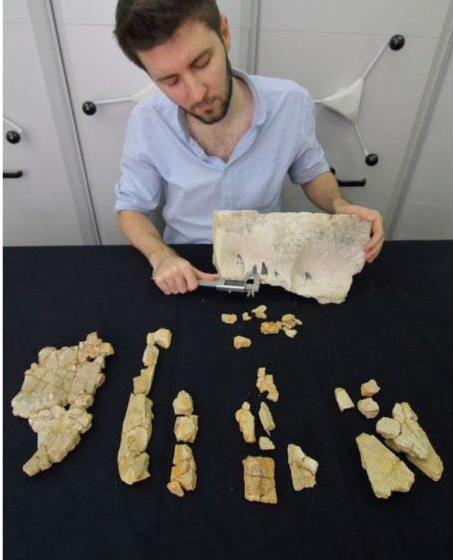Polish Giant Marine Reptile Found in Cornfield
A pair of Polish palaeontologists have published a scientific paper describing the discovery of a large, Late Jurassic pliosaur from a site located in a cornfield in the north-eastern part of the Holy Cross Mountains close to the village of Krzyżanowice in southern Poland. This is the first pliosaur to have been found in Poland.
The First Pliosaur Discovered in Poland
Scientists are puzzled with regards to the vertebrate fauna identified at the site, the pliosaur fossils are very similar to pliosaur remains associated with the Late Jurassic Boreal/Sub-Boreal localities of the Kimmeridge Clay in England and the Svalbard Archipelago in the Arctic. However, the fossils of turtles and marine crocodiles found at this location have more in common with the fauna associated with ecosystems found much further to the south.
Teeth and a Partially Preserved Jaw of the Polish Pliosaur
Picture credit: Polish Academy of Sciences
Fearsome Pliosaurs
The Pliosauridae are a family of marine reptiles within the clade Plesiosauria. They are often referred to as the “short-necked plesiosaurs”, as unlike plesiosaurs, these reptiles evolved massive skulls on short, powerful necks. Pliosaurs were geographically widespread throughout the Jurassic and Cretaceous with fossil discoveries having been made in Europe, including the UK, Australia, and the Americas. It is believed they originated in the Early Jurassic and survived into the Late Cretaceous.
A Typical Pliosaur – Pliosaurus
The picture (above) shows a CollectA Deluxe 1:40 scale pliosaur figure.
To view this range of prehistoric animals: CollectA Deluxe Prehistoric Life Models.
A Marine Reptile Giant
The fossilised remains, although fragmentary, suggest an animal around ten metres in length. The presence of such a large, apex predator indicates that the ecosystem was particularly rich and diverse. The pliosaur has yet to be scientifically described but it is very likely a new genus. It swam in the warm, tropical sea in the central portion of the European archipelago, as during the Late Jurassic, sea levels were much higher and western Europe consisted of a series of large islands surrounded by a shallow sea.
Examining the Fossilised Bones and Teeth

Picture credit: Polish Academy of Sciences
Identifying a Late Jurassic Faunal Boundary
The unusual mix of vertebrate fossils, some similar to animals that lived further north, whilst others resemble marine animals that lived in more southerly palaeolatitudes, has led the researchers to suggest that the fossils preserved in this part of Poland represent an ancient faunal boundary. A faunal boundary is an area of demarcation between two ecosystems that are similar but contain different members.
The unique composition of the Krzyżanowice-site vertebrate fauna demonstrates that, during the Late Jurassic this new locality was located in the transitional palaeobiogeographic line referred to in the scientific paper as the “Matyja-Wierzbowski Line”. The fossils represent the boundary between two ecosystems, an area where some faunal mixing between the two ecosystems occurred.
Identifying the “Matyja-Wierzbowski Line” in the Upper Jurassic Marine Deposits of Europe

Picture credit: Polish Academy of Sciences with additional annotation by Everything Dinosaur
For a more in-depth explanation of faunal boundary, please refer to this article that discusses “The Wallace Line”, a faunal boundary in south-east Asia proposed by the English biologist Alfred Russel Wallace: New Species of Rat Discovered in Sulawesi.
The scientific paper: “New marine reptile fossils from the Late Jurassic of Poland with implications for vertebrate faunas palaeobiogeography” by Daniel Tyborowski and Błażej Błażejowski published in the Proceedings of the Geologist’s Association.
Everything Dinosaur’s website: Everything Dinosaur.








Leave A Comment